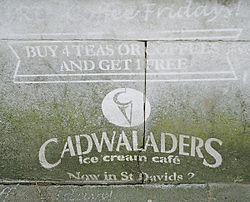- Reverse graffiti
-
Reverse graffiti, also known as clean tagging, dust tagging, grime writing, green graffiti or clean advertising, is a method of creating temporary or semi permanent images on walls or other surfaces by removing dirt from a surface. It is often done by removing dirt/dust with the fingertip(s) from windows or other dirty surfaces, such as writing 'wash me' on a dirty vehicle. Others, such as artist Moose, use a cloth or a high power washer to remove dirt on a larger scale.
Contents
Origin
English artist Paul Curtis aka Moose is one of the first street artists to make an art piece using the reverse graffiti technique. He discovered the technique at his dishwashing job, as he explains in his documentary.
The first large scale reverse graffiti art piece was made by Alexandre Orion in 2006, the intervention Ossario with over 1000 foot is washed by the municipality of São Paulo in the end of the video.
Street artists such as Banksy or Alexandre Orion have made works with reverse graffiti as well.
Commercially
As with traditional graffiti, nowadays the technique is also explored commercially as an original way of out-of-home advertising to reach consumers in an unconventional new way. The pilot campaign for Telfort was highly successful and made it to several blogs [1] and advertising magazines.[2]
Since then, large companies as Microsoft, the BBC and Smirnoff have advertised their products in this way.[3] In this context, marketers call it, "clean advertising" or "clean graffiti".
Environment impact
Because reverse graffiti is temporary, biodegradable, and no hard materials such as ink, paper, or chemicals are used in its production, reverse graffiti is considered an environmentally friendly way of advertising.[4] Although water is used spraying the advertisements, some companies use a water compensating program.
Legality
There have been several instances of authorities attempting to prosecute those performing clean advertising, but prosecution has been difficult due to the temporary and non-destructive nature of the practice.[5][6] Moreover, while adding something to the sidewalk like paint is illegal, cleaning is not. Thus, companies or artists offering their reverse graffiti services are operating in a legal gray area. In the UK it is not a grey area as the Town & Country Planning Act 1990 section 224 makes it very clear that advertising without consent is a criminal offence. See http://www.communities.gov.uk/publications/planningandbuilding/outdooradvertisements
From January 2011, CURB Media worked with Leeds to help the council become the first globally to regulate clean advertising, marking the start of clean media's development into the mainstream. Since this time numerous other councils across the UK have started to regulate the media as means of generating revenue and delivering local and national advertising. [7]
References
- ^ "Profnews: GreenGraffiti sprays environmentally friendly ads on streets". Profnews (The Netherlands). 6-12-2008. http://www.profnews.nl/901524/greengraffiti-spuit-milieuvriendelijke-advertenties-op-straat. Retrieved 21-03-2011.]
- ^ "Green Graffiti". Creatie (The Netherlands). 05-08-2011. http://www.creatie.nl/creatie/select/expression/63016.do. Retrieved 21-03-2011.]
- ^ Carter, Helen (2004-10-15). "Graffiti artist's new form of street art under fire". The Guardian (London). http://www.guardian.co.uk/uk_news/story/0,3604,1328139,00.html. Retrieved 2007-07-22.
- ^ Brenhouse, Hillary (03-06-2010). "Marketing firms clean up with 'Reverse Graffiti'". The New York Times. http://www.nytimes.com/2010/06/04/business/energy-environment/04iht-rbogad.html?_r=1. Retrieved 21-03-2011.]
- ^ Morgan, Richard (2006-12-10). "NY Times article on reverse graffiti". The New York Times. http://www.nytimes.com/2006/12/10/magazine/10section3a.t-7.html?. Retrieved 2007-01-24.
- ^ Baron, John (n.d.). "Pavement ads under fire as Leeds council is accused of 'environmental crime'". Guardian Leeds (London). http://www.guardian.co.uk/leeds/2011/feb/14/leeds-city-council-pavement-adverts.
- ^ Leeds City Council: 12 month trial of pavement advertising in selected locations
Street art Culture Activism · Aerosol paint · Culture jamming · Direct action · Graffiti (terminology · use theory) · Guerrilla art · Hip hop culture · Installation art · Kolam · Murals · Propaganda · Reverse graffiti · Screenprinting · Spray paint art · Stencil graffiti · Sticker art · Subway Art · Yarn bombing
Lists of artists Companies Related articles Categories:- Graffiti and unauthorised signage
Wikimedia Foundation. 2010.

